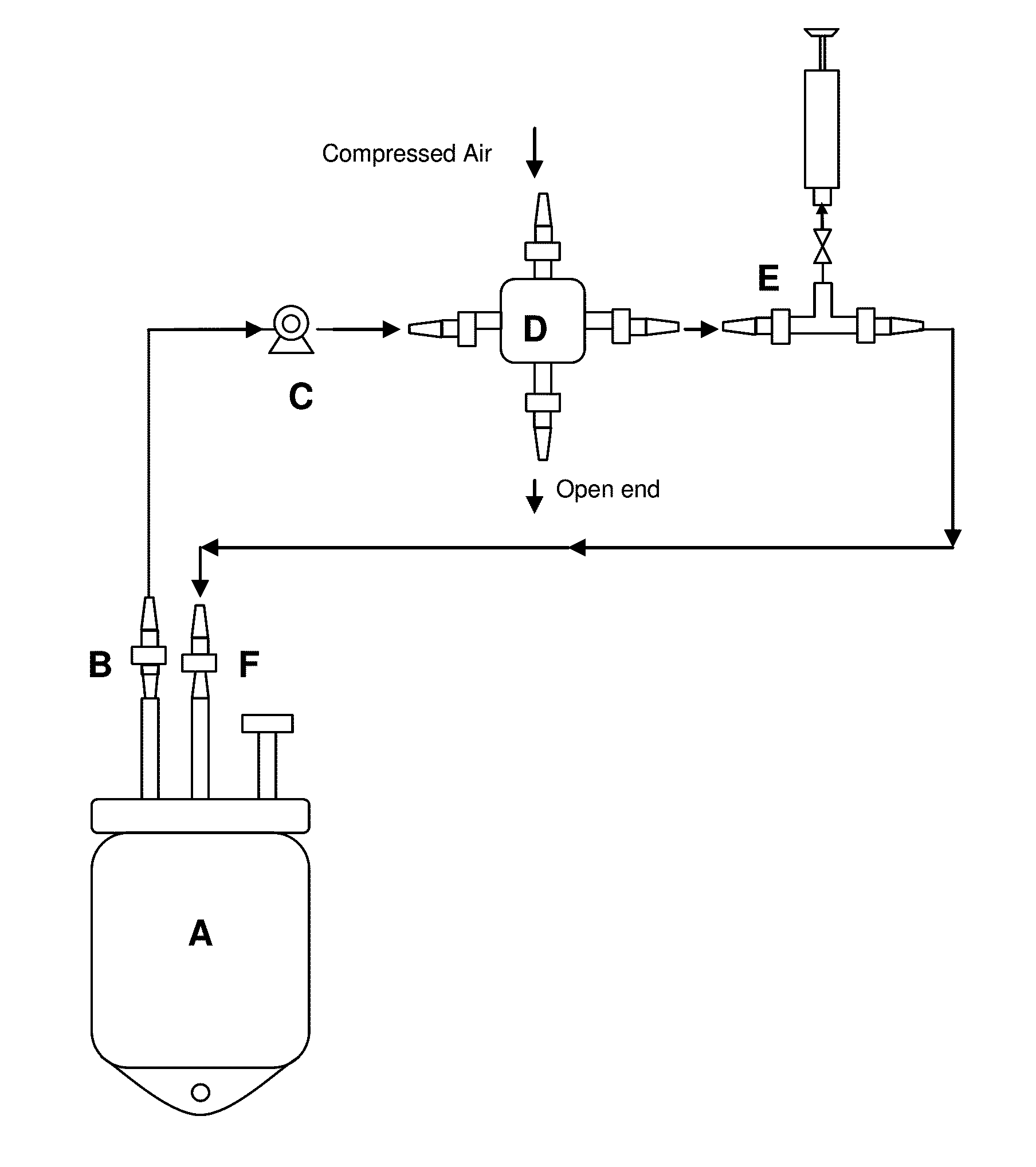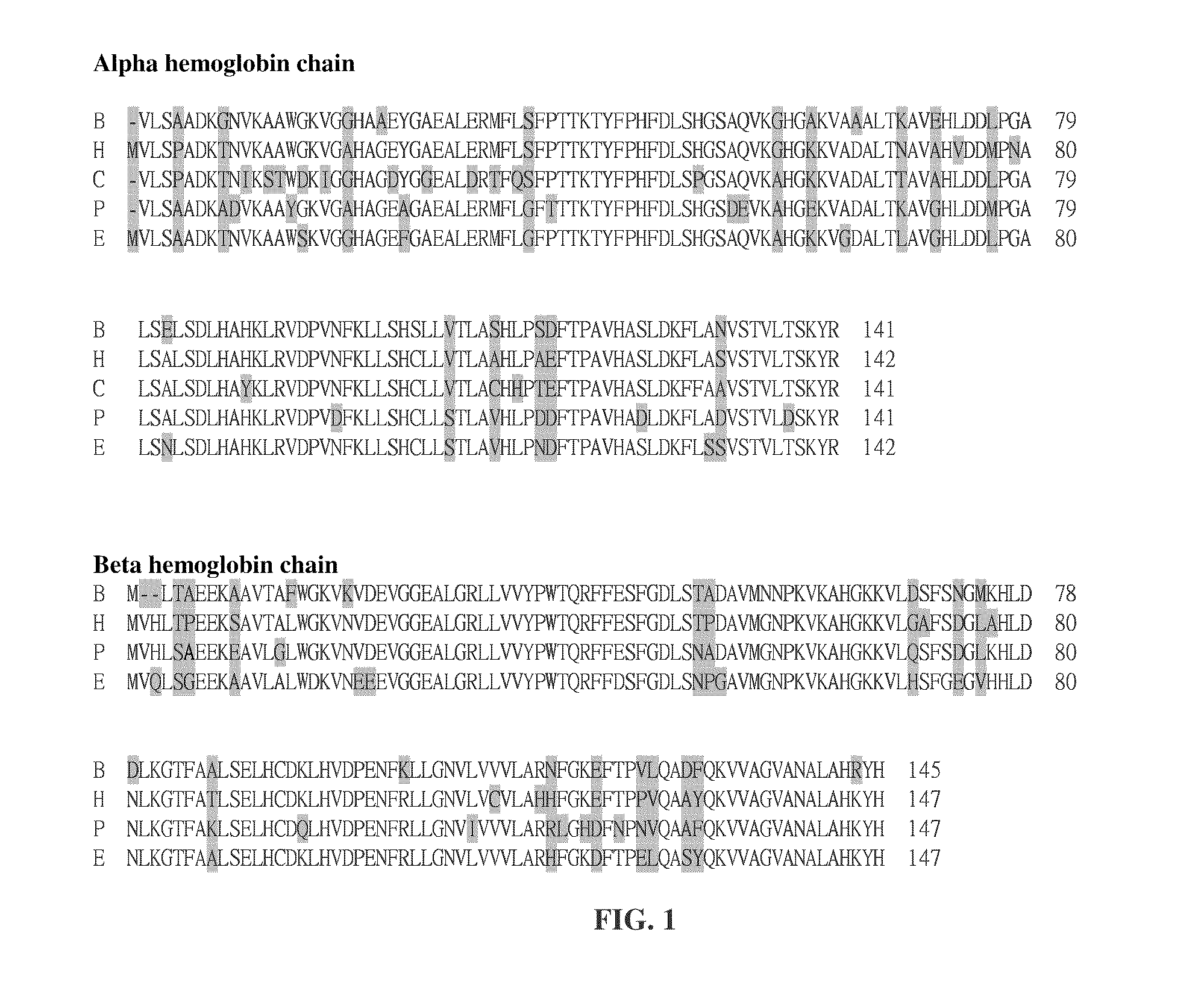Method for the preparation of a high-temperature stable oxygen-carrier-containing pharmaceutical composition and the use thereof
a high-temperature stable, pharmaceutical technology, applied in the direction of packaging foodstuffs, packaged goods types, extracellular fluid disorders, etc., can solve the problems of affecting the sustainability of functional hemoglobin in circulation, affecting and substantial renal injury, so as to enhance the sensitivity to radiation and chemotherapeutic agents, and improve the oxygenation of tumor cells
- Summary
- Abstract
- Description
- Claims
- Application Information
AI Technical Summary
Benefits of technology
Problems solved by technology
Method used
Image
Examples
example 1
Overall Process
[0062]A schematic flow diagram of the process of the present invention is illustrated in FIG. 2. Bovine whole blood is collected into an enclosed sterile container / bag containing 3.8% (w / v) tri-sodium citrate solution as anti-coagulant. Blood is then immediately mixed well with tri-sodium citrate solution to inhibit blood clots. Red blood cells (RBC) are isolated and collected from plasma and other smaller blood cells by an apheresis mechanism. A “cell washer” is used for this procedure with gamma sterilized disposable centrifuge bowl. RBC are washed with an equal volume of 0.9% (w / v sodium chloride) saline.
[0063]Washed RBC are lysed to release hemoglobin content by manipulating hypotonic shock to the RBC cell membrane. A specialized instant cytolysis apparatus for RBC lysis device depicted in FIG. 3 is used for this purpose. Following RBC lysis, hemoglobin molecules are isolated from other proteins by tangential-flow ultrafiltration using 100 kDa membrane. Hemoglobin...
example 2
Time & Controlled Hypotonic Lysis and Filtration
[0065]Bovine whole blood is freshly collected and transported under a cool condition. The red blood cells are separated from the plasma via a cell washer and subsequently with a 0.65 μm filtration. After washing the red blood cells (RBC) filtrate with 0.9% saline, the filtrate is disrupted by hypotonic lysis. The hypotonic lysis is performed by using the instant cytolysis apparatus depicted in FIG. 3. The instant cytolysis apparatus includes a static mixer to assist in cell lysis. A RBC suspension with controlled hemoglobin concentration (12-14 g / dL) is mixed with 4 volumes of purified water to generate a hypotonic shock to RBC cell membranes. The period of hypotonic shock is controlled to avoid unwanted lysis of white blood cells and platelets. The hypotonic solution passes through the static mixer portion of the instant cytolysis apparatus for approximately 30 seconds. The shock is terminated after 30 seconds by mixing the lysate wit...
example 3
Viral Clearance Study on Stroma-Free Hemoglobin Solution
[0067]In order to demonstrate the safety of the product from this invention, the virus removal abilities of (1) 0.65 μm diafiltration step and (2) 100 kDa ultrafiltration step are demonstrated by virus validation study. This is done by the deliberate spiking of a down-scaled version of these two processes with different model viruses (encephalomyocarditis virus, pseudorabies virus, bovine viral diarrhoea virus and bovine parvovirus). In this study, four types of viruses (see the following table 2) were used. These viruses vary in their biophysical and structural features and they display a variation in resistance to physical and chemical agents or treatments.
TABLE 2SizeTarget VirusModel VirusTaxonomyGenomeStructure[nm]Stability*Hepatitis CBovine viral diarrhea virusFlaviviridaessRNAenveloped40-60lowvirus (HCV)(BVDV)—EncephalomyocarditisPicornavirusssRNAnon-enveloped25-30mediumvirus (EMCV)ParvovirusBovine parvovirusParvoviridaes...
PUM
| Property | Measurement | Unit |
|---|---|---|
| Fraction | aaaaa | aaaaa |
| Fraction | aaaaa | aaaaa |
| Volumetric flow rate | aaaaa | aaaaa |
Abstract
Description
Claims
Application Information
 Login to View More
Login to View More - R&D
- Intellectual Property
- Life Sciences
- Materials
- Tech Scout
- Unparalleled Data Quality
- Higher Quality Content
- 60% Fewer Hallucinations
Browse by: Latest US Patents, China's latest patents, Technical Efficacy Thesaurus, Application Domain, Technology Topic, Popular Technical Reports.
© 2025 PatSnap. All rights reserved.Legal|Privacy policy|Modern Slavery Act Transparency Statement|Sitemap|About US| Contact US: help@patsnap.com



